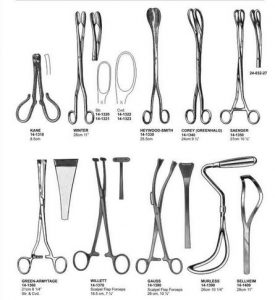Anyone who has had a Caesarean knows how frustrated it can be that you couldn’t give birth naturally. This is what convinced Dr. Bénédicte Simon, surgeon, gynecologist-obstetrician in Versailles to perform cesarean sections by extra peritoneal route.

At first, it looks like a classic cesarean: the operation takes place in the operating room under an epidural or spinal anesthesia, and the obstetrician cuts the skin horizontally at the level of the pubis with the help of cesarean section surgical instrument set. But then, instead of incising the aponeurosis (the sheath of the muscles) horizontally, the surgeon opens it on the left side vertically, so in the same direction as the muscle fibers.
Then it bypasses the peritoneum (thin membrane that surrounds the viscera) instead of incising it and goes underneath to access the uterus. “It may seem like details, but it allows the mother to get up, walk and move painlessly a few hours after giving birth”, specifies Dr. Bénédicte Simon, surgeon, obstetrician-gynecologist, at the Franciscan clinic in Versailles.
Beyond the technical aspect, the extra peritoneal cesarean section is a real plus for mothers. With less strong analgesia (since the peritoneum is no longer cut), the risks of nausea and drop in blood pressure are reduced. And the woman actively participates in her childbirth. Indeed, once the obstetrician has cut the uterus and grabbed the baby’s head, he asks the mother to blow into a small mouthpiece.
“Spinal anesthesia does not prevent the pushing force that comes from the rib cage”, explains the gynecologist. With each exhalation in this mouthpiece, the abdominals contract, which facilitates the progression of the baby and allows the woman to expel it on her own, as in a vaginal birth.
Simpler diaper suites
From birth, the dad can cut the cord if he wishes, and the mom keeps her baby skin to skin while the surgeon sews up the internal incisions and places invisible glue on the external scar. No stitches or staples that pull and that must then be removed. When the new mother returns to her room, her infusion has already been withdrawn in the recovery room, her bladder is not asleep, she has no catheter or bandage, her transit is normal, she is free to move around.
Four hours after the procedure, she can eat, get up, take a shower or take care of her baby. Usually 3 days later, instead of the usual 5, mom and baby can go home. “In 75% of cases, they could even go out the next day,” says the surgeon. Thanks to this new technique, the mother can fully take charge of her baby, feed him, change him, bathe him, cuddle him without hindrance or pain, from the first day.
A method practiced by only 5 obstetricians
So how can we explain that only 5 gynecologists-obstetricians perform extra peritoneal cesarean section in France and that it has not yet entered hospitals? Dr. Simon, who has already given birth to 600 women in this way, wonders and is surprised that this technique does not arouse more interest on the part of his colleagues. Of course, this requires additional training for the obstetrician surgeon and a different investment from the whole team, but everyone is a winner, both humanly and economically.
For more details, please visit: jimymedical.co.uk
 Bloggers Trend Keeping You Up To Date
Bloggers Trend Keeping You Up To Date
